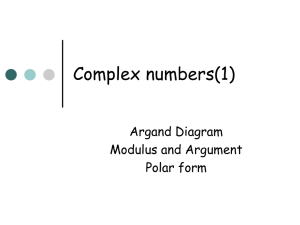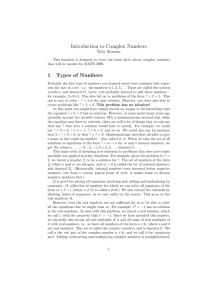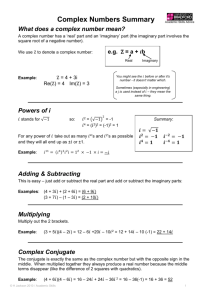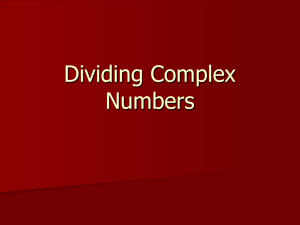Complex Numbers - Hinchingbrooke
advertisement
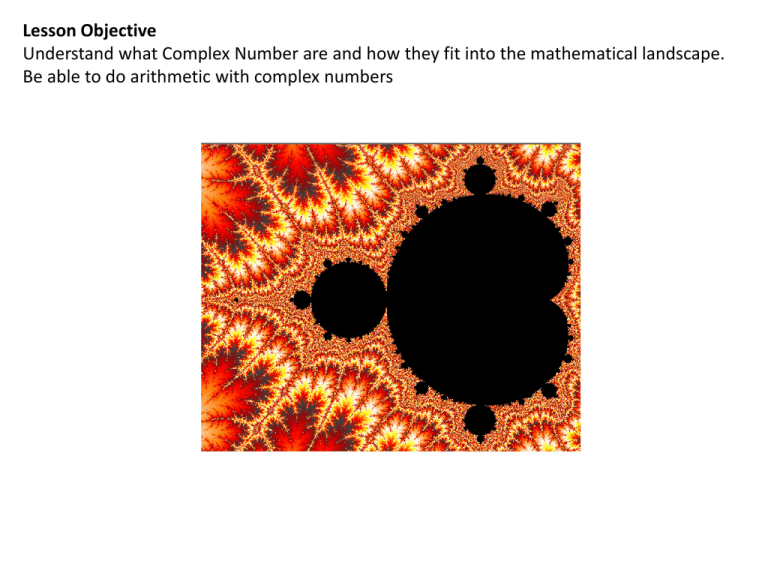
Lesson Objective Understand what Complex Number are and how they fit into the mathematical landscape. Be able to do arithmetic with complex numbers Solve the equations: x2 +4x + 1 = 0 x2 +4x + 4 = 0 x2 +4x + 6 = 0 What can we say about the graph of: y = x2 + 4x + c? What are the conditions for each case? Arithmetic of complex numbers: Let z = 3 + 4j w = 2 – 5j Find: a) w + z b) z – w c) z2 d) zw 𝑧 e) 𝑤 Complex Conjugates, Uniqueness and Real and Imaginary Parts: If z = 3 + 4j we say that z* = 3 – 4j is the Complex Conjugate of z we say that Re(z) = 3 is the real part of z we say that Im(z*) = -4 is the imaginary part of z Two complex numbers are identical if the imaginary and real parts are the same; In other words if 3 - 2j = a + bj a must be equal to 3 b must be equal to -2 Complex Conjugates, Uniqueness and Real and Imaginary Parts: If z = 3 + 4j we say that z* = 3 – 4j is the Complex Conjugate of z we say that Re(z) = 3 is the real part of z we say that Im(z*) = -4 is the imaginary part of z Let w = 2 – 5j Find: a) w* b) z + w* c) w - z* e) w*z * f) (zw)* g) 1 w∗ d) (z + w)* 1 ∗ h) ∗ 𝑧 Complex Conjugates, Uniqueness and Real and Imaginary Parts: If z = 3 + 4j we say that z* = 3 – 4j is the Complex Conjugate of z Let w = 2 – 5j Find: a) w* b) z + w* c) w - z* e) w*z * f) (zw)* g) 1) If y is a complex number y = a + bj x is a complex number x = c + dj y + y * = 2Re(y) y - y* = 2Im(y) (xy)* = x*y * (x*)* = x 1 1 2Re(y) e) 𝑦 + 𝑦 ∗= 𝑎2+𝑏2 Prove that: a) b) c) d) From FP1 page 53 1 w∗ d) (z + w)* 1 ∗ h) ∗ 𝑧 2) Find real numbers a and b (with a>0) such that a) (a + bj)2 = 21 + 20j b) (a + bj)2 = -40 - 42j 3) Find real numbers ‘a’ and ‘b’ such that 𝑎 𝑏 + =1−𝑗 3+𝑗 1+2𝑗 4) Find real numbers z for which z2 = 2z* 5) Solve z + jw = 13 3z – 4w = 2j for complex numbers z and w Complex Conjugates, Uniqueness and Real and Imaginary Parts: If z = 3 + 4j we say that z* = 3 – 4j is the Complex Conjugate of z Let w = 2 – 5j Find: a) w* 2+5j e) w*z * 26+7j b) z + w* 5+9j f) (zw)* 26+7j g) 1) If y is a complex number y = a + bj x is a complex number x = c + dj Re(y + y *) = 2a Im(y - y*) = 2b (xy)* = x*y * (x*)* = x 1 1 2Re(y) e) 𝑦 + 𝑦 ∗= 𝑎2+𝑏2 Prove that: a) b) c) d) From FP1 page 53 c) w - z* 1 w∗ -1-j (2-5j)/29 d) (z + w)* 5+j 1 ∗ h) ∗ (3-4j)/25 𝑧 2) Find real numbers a and b (with a>0) such that a) (a + bj)2 = 21 + 20j b) (a + bj)2 = -40 - 42j 3) Find real numbers ‘a’ and ‘b’ such that 𝑎 𝑏 + =1−𝑗 3+𝑗 1+2𝑗 4) Find real numbers z for which z2 = 2z* 5) Solve z + jw = 13 3z – 4w = 2j for complex numbers z and w Lesson Objective Be able to display complex numbers on an Argand Diagram Understand how to find the modulus and argument of a complex number Consider z = 3 +4j Re(z) = Im(z) = 𝑧 = Arg(z) = and w = -2 – 5j Re(w) = Im(w) = 𝑤 = Arg(w) = How can we represent the following on the Argand diagram: a) z + w ? b) z – w ? What is 𝑧 − 𝑤 ? What does it represent? To generate a mandelbrot set: Solve the equation z2 + 1 =0 By using an iterative approach. (Like C3 coursework) Count the number of iterations required to get within an acceptable margin of the solution. Plot the starting value on an Argand diagram, with a colour that corresponds to the number of steps until convergence. Eg Rearrange to make z = -1/z Choose 1+i as starting value Keep iterating until within a small radius of i. 1) Write down the modulus and the argument of these complex numbers: a) 2 + 2j b) -3 +4j c) -3-4j d) 3j 2) What can you say about the modulus and argument of z* compared to z? 3) Let z be a complex number On the Argand diagram, show all the complex numbers ‘z’, such that: a) 𝑧 =6 𝜋 b) Arg(z) = 3 c) 𝑧 − 3 =5 d) 𝑧 − 3 − 4𝑗 =5 𝜋 e) Arg(z-3-4j) = 3 f) 𝑧 − 3 = 𝑧 − 3𝑗 g) 𝑧 − 2 =2 𝑧 − 3𝑗 e) -2 Let ‘z’ be a complex number On the Argand diagram, show all the complex numbers ‘z’, such that: 𝑧 − 3 − 4𝑗 =5 Let ‘w’ be a complex number On the Argand diagram, show all the complex numbers ‘w’, such that: 𝑤 − 3 − 4𝑗 = 𝑧 − 3 + 2𝑗 How does this differ from: 𝑤 − 3 − 4𝑗 > 𝑧 − 3 + 2𝑗 𝑤 − 3 − 4𝑗 < 𝑧 − 3 + 2𝑗 ? ? z 3 2 z 2 Note that: z a represents the distance from the complex number a to the complex number z Arg(z – a) represents the angle to the complex number z from the complex number a measured from a line parallel to the +ve part of the real axis If z is a complex number x + iy then: Re(z) = x Im(z) = y z* = The complex conjugate of z= x - iy z 3j 4 z2 6 z 42 j 6 z 1 z j z 2 2 z 1 z2j 3z Re( z ) Im(z ) Im(z ) 0 2 2 Arg ( z 1) 3 Arg ( z 2 j ) Arg ( 2 z ) Arg ( z ) 4 3 4 Arg ( z 1) Arg ( z 1) 4 Arg ( z j ) Arg ( z j ) 6 Re(z ) 2 1 Re( z * ) 0 z z2 Re 0 z Lesson Objective Modulus and Argument Form and the beginnings of powerful arithmetic Write down the modulus and the argument of these complex numbers: a) a = 1 + 2j b) b = 2j c) c = -j d) d = -1-j Lesson Objective Modulus and Argument Form and the beginnings of powerful arithmetic Write down the modulus and the argument of these complex numbers: a) a = 1 + 2j b) b = 2j c) c = -j d) d = -1-j Section A Find ab ab2 ab3 ab4 ……. In each case plot the new complex number on the Argand diagram and find its modulus and argument Generalise for abn Section B What can you say about the modulus and 𝑎 argument of ad? What about 𝑑? Generalised results: Let w be a complex number in the form a + ib Then: The modulus of w = 𝑤 = 𝑎2 + 𝑏2 The argument of w = Arg(w) = the angle that w makes with the +ve section of the real axes (usually given between 180 and -180 degrees or We can write w as: w = 𝑤 (𝑐𝑜𝑠∅ + jsin∅) this is called modulus/argument form (or polar form) When two complex numbers are multiplied together, the resulting complex number: Will have an argument = to the sum of the two original arguments and a modulus =to the product of the two original moduli. Puzzle 1 The points 1 + j and 3 + 4j are two adjacent corners of a square. Where are the other corners? Can you solve this problem? More importantly, how can you solve it using complex numbers? Puzzle 2 Suppose that 1 + j and 3 + 4j were two adjacent corners of an equilateral triangle, where would the final vertex be? This is much easier to solve using complex numbers! Puzzle 3 Can we generalise this method to a regular ‘n’ sided shape? This really demonstrates just how cool complex numbers are!!!!!!!! Lesson Objective Understand the Fundametal Thm of Algebra be able to solve cubic/quartic equations with Real coefficients even when some roots are complex Write down any quadratic equation with complex roots. Solve it. What do you notice about the solutions? Is it true that (wn)* (w*)n ? Try it with (wn)* How can we prove this key result? Lesson Objective Understand the Fundamental Thm of Algebra and be able to solve cubic/quartic equations with Real coefficients even when some roots are complex Starter: Is it true that: (w*)n = (wn)* for all n ≥ 0 where w is a complex number? Try it with (w*)3 How can we prove this key result? Lesson Objective Understand the Fundamental Thm of Algebra be able to solve cubic/quartic equations with Real coefficients even when some roots are complex Write down any quadratic equation with complex roots? Solve it. What do you notice about the solutions? Lesson Objective Understand the Fundamental Thm of Algebra be able to solve cubic/quartic equations with Real coefficients even when some roots are complex Write down any quadratic equation with complex roots? Solve it. What do you notice about the solutions? The Fundamental Thm of algebra states that any polynomial equation of degree ‘n’ will have exactly ‘n’ solutions (if you count repeated roots). The Complex Conjugate Root Thm goes further, and states that, as long as the coefficients are real, the solutions will come in complex conjugate pairs. Proof of Fundamental Thm of Algebra (Go to University – it took Gauss years) Proof of the Complex Conjugate Root Thm Consider: αzn + βzn-1 + γzn-2 + …….. + δz2 + εz + ζ = 0 Then ‘z’ is a solution to the equation Now consider: (αzn + βzn-1 + γzn-2 + …….. + δz2 + εz + ζ)* = (0)* (αzn)* + (βzn-1)* + (γzn-2)* + …….. + (δz2)* + (εz)* + (ζ)* = (0)* α*(zn)* + β* (zn-1)* + γ* (zn-2)* + …….. + δ* (z2)* + ε* (z)* + (ζ)* = 0* α*(z*)n + β* (z*)n-1 + γ* (z*)n-2 + …….. + δ* (z*)2 + ε* (z*) + (ζ*) = 0* α(z*)n + β (z*)n-1 + γ (z*)n-2 + …….. + δ (z*)2 + ε (z*) + ζ = 0* Example Shows the 2 + j is a solution to z3 – z2 -7z + 15 = 0 Hence find all the other roots. Example Give than z = -2 + j is a solution to z4 + az3 +bz2 +10z + 25 = 0 Find the values of a and b Hence factorise the cubic and find all 4 solutions Example Give than z = -2 + j is a solution to z4 + az3 +bz2 +10z + 25 = 0 Find the values of a and b Hence factorise the cubic and find all 4 solutions a=2b=2 Other two solutions are 1 + 2j and 1 – 2j
